Key takeaways:
- Understanding special needs education involves recognizing individual challenges and fostering emotional and social development.
- Lesson adaptation is crucial, empowering students through tailored methods and diverse teaching strategies that engage their strengths.
- Collaboration among educators, specialists, and parents enhances support for students, creating inclusive learning environments.
- Utilizing visual aids, technology, and flexible classroom arrangements can significantly improve engagement and learning outcomes for students with special needs.
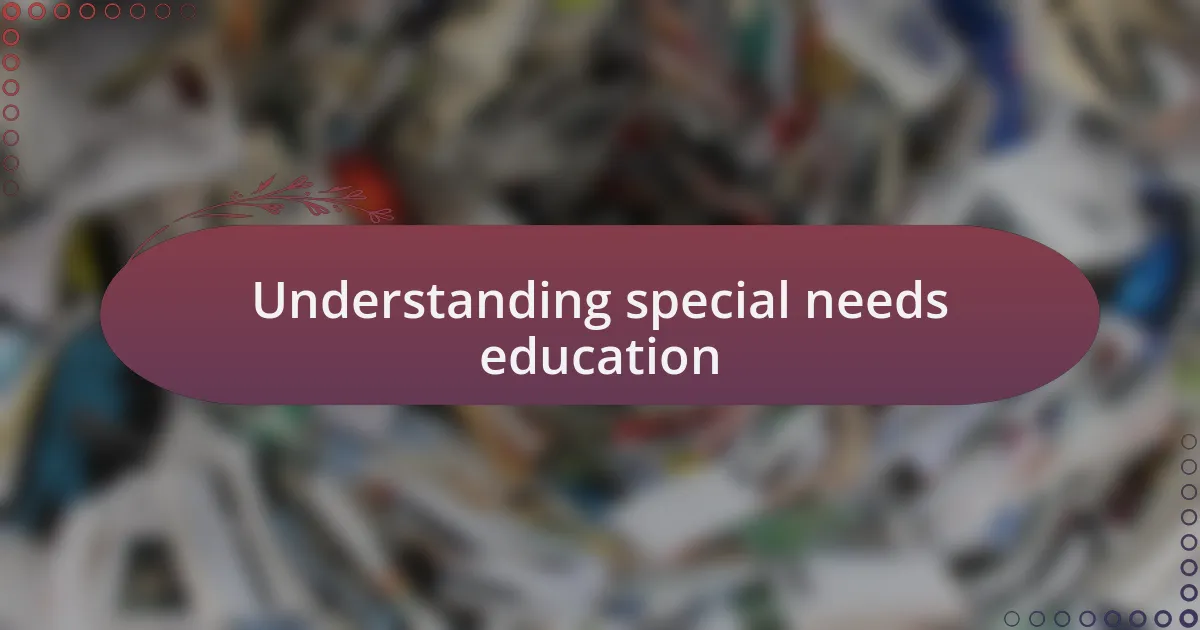
Understanding special needs education
Understanding special needs education requires a compassionate approach that recognizes the diverse challenges faced by learners. I remember a student named Mia, who had difficulty with conventional learning methods. Seeing her struggle made me realize that traditional teaching doesn’t fit everyone; it sparked my journey toward creating tailored methods to help her thrive.
In my experience, special needs education not only addresses academic gaps but also focuses on nurturing emotional and social development. How often do we consider that a child may excel in one area while needing support in another? When I worked with a little boy who was brilliant at art but struggled with reading, we used his creativity as a bridge to enhance his literacy skills. This holistic perspective allows us to meet each child where they are.
Moreover, the importance of collaboration among educators, parents, and specialists cannot be overstated. I distinctly recall a team meeting where we brainstormed ways to support a child with autism. The shared insights transformed my understanding of what truly supportive educational environments look like. Together, we built an inclusive space that celebrated differences, fostering growth in ways I had never anticipated.
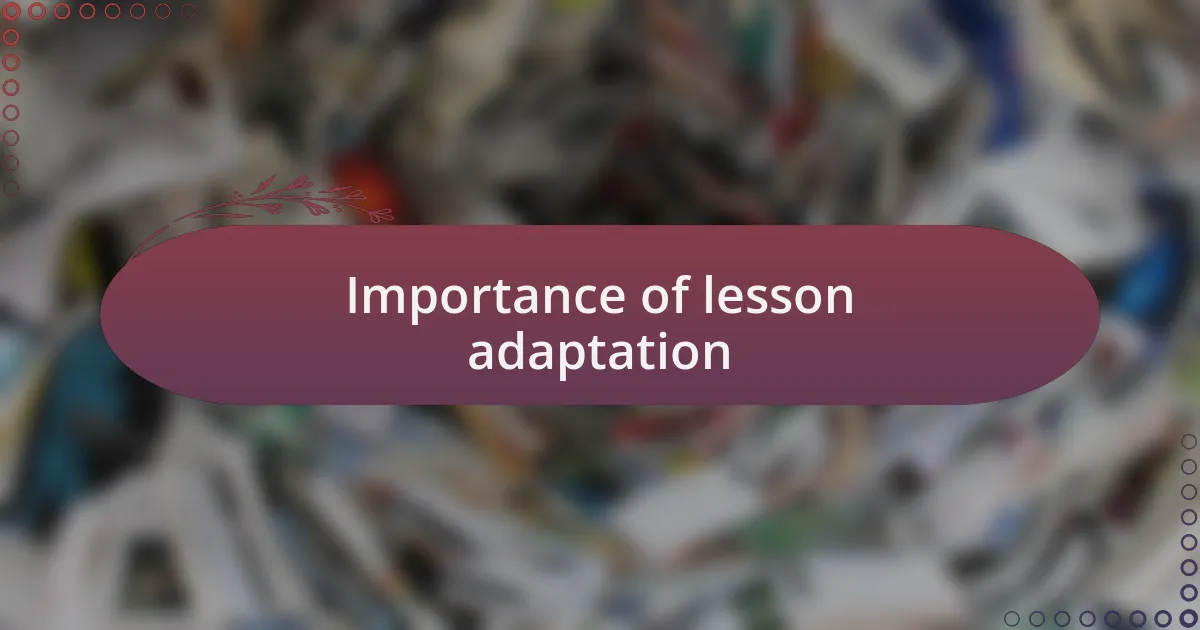
Importance of lesson adaptation
Adapting lessons is crucial because it acknowledges the unique strengths and challenges of each learner. I remember a moment in my classroom when I adjusted a math lesson for a student with dyscalculia by incorporating visual aids and hands-on activities. It was incredible to see his confidence bloom as he started engaging with numbers in a way that made sense to him.
Furthermore, the process of lesson adaptation empowers students to take an active role in their learning. I often wonder how many kids disengage because they don’t relate to the traditional methods used in classrooms. By using a variety of approaches, such as integrating technology or connecting lessons to real-life scenarios, I’ve witnessed students spark their curiosity and enthusiasm for learning again.
Ultimately, adapting lessons creates an environment where every student can thrive. I once had a young girl with selective mutism who rarely spoke in class; however, when I implemented quiet group activities with visual resources, she began to participate more. Isn’t it heartwarming to see students find their voice when we meet them where they are? It reinforces the idea that effective teaching is about recognizing and addressing each student’s individual needs.
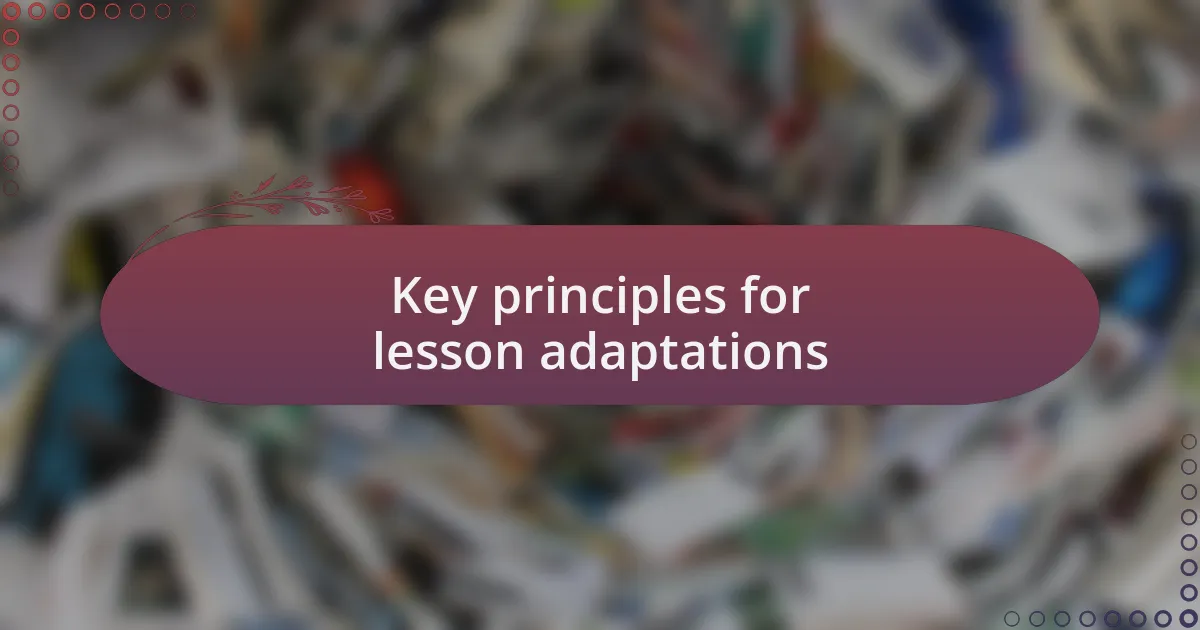
Key principles for lesson adaptations
When adapting lessons, I find that flexibility is key. For instance, I had a student who struggled with auditory processing, so I modified a reading session by providing written instructions alongside an audio recording. Watching him absorb the material without feeling overwhelmed was a reminder of how essential it is to tailor our approaches based on individual needs.
Another principle I value is the use of clear and consistent objectives. I recall preparing a science experiment where I explicitly outlined what students would learn and how they could demonstrate their understanding. This clarity empowered all my students, especially those with attention challenges, to stay focused and engaged throughout the activity. Have you ever found that students thrive when they know exactly what is expected?
Finally, collaboration among educators and specialists cannot be overlooked. I partnered with a speech therapist to adapt a language lesson for a group of students with varying communication needs. The insights I gained were invaluable; it reminded me of the importance of pooling resources and knowledge. Doesn’t it make you think about how much more effective we can be when we work as a team?

Strategies for practical adaptations
When I think about practical adaptations, I often focus on the environment in which learning takes place. For example, I once rearranged a classroom for a student with sensory sensitivities, creating a quiet corner filled with calming materials. It amazed me to see how such a small change made a big difference; that space became a sanctuary where the student could regroup and re-engage without the overwhelming distractions of a traditional setting. Have you noticed how sometimes, changing just the surroundings can open up new pathways to learning?
In my experience, technology plays a transformative role in lesson adaptations. I remember introducing interactive apps to assist students with learning disabilities in math. One student who had previously struggled with traditional methods suddenly found joy in learning, as the visual and interactive elements allowed her to visualize problems in a new way. Engaging with the material through technology sparked her curiosity and made her an active participant in her learning journey. It makes me wonder how many more students could thrive with the right tools at their fingertips.
I’ve learned that simplifying instructions can have a profound impact as well. During a history lesson, I broke down complex concepts into bite-sized pieces, using visuals and hands-on activities to illustrate each component. The difference was palpable; students who typically struggled to keep up were able to grasp the content more easily and engage in thoughtful discussions. Have you explored the idea that less can truly be more when it comes to guiding students through challenging material?
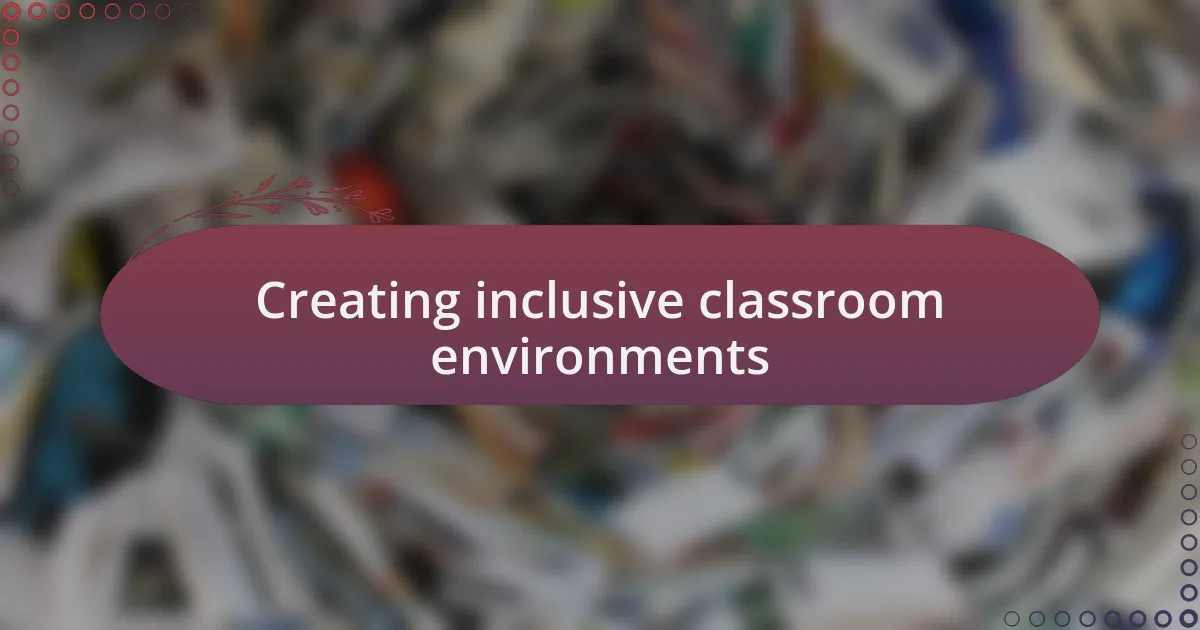
Creating inclusive classroom environments
Creating inclusive classroom environments requires a thoughtful approach that considers the diverse needs of every student. I once collaborated with a co-teacher to transform our classroom layout into a more flexible space, incorporating moveable furniture. This shift allowed students to choose seating arrangements that worked best for their learning styles; I saw students thrive in their chosen setups, negotiating with peers and taking active ownership of their space. Have you ever thought about how much control over their environment can affect a student’s motivation?
Additionally, fostering a sense of belonging is crucial in an inclusive classroom. I remember a student who felt isolated because of his unique challenges. By implementing regular community-building activities, such as sharing circles, I witnessed his confidence blossom. As students shared their own stories, he realized he wasn’t alone in his struggles. How powerful is it to know that we are all in this together?
Another key aspect is the importance of visual supports for all learners. I’ve often used charts and graphics to reinforce concepts during lessons. For instance, when studying ecosystems, I integrated visuals that illustrated the food chain, which helped clarify complex relationships. It was rewarding to watch students point out connections they hadn’t understood before. How could visual tools help you bridge gaps in understanding in your classroom?
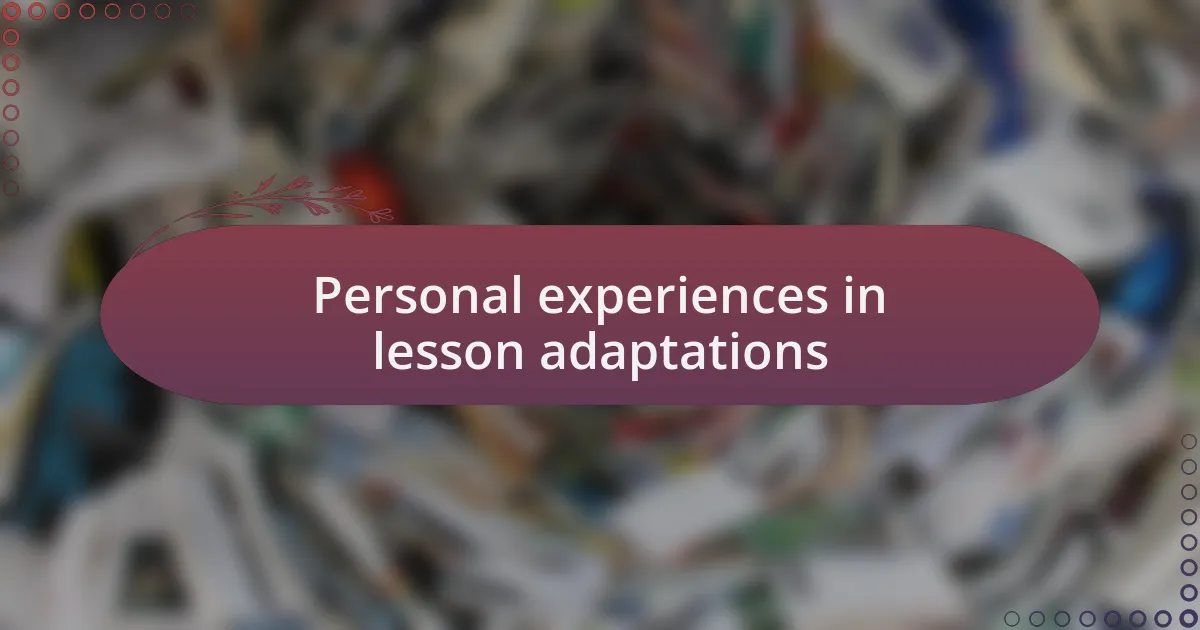
Personal experiences in lesson adaptations
I recall a time when I adapted a math lesson for a student with dyscalculia. Instead of relying solely on traditional methods, I incorporated hands-on activities using three-dimensional objects. This tactile approach not only made math concepts more accessible but also sparked the student’s enthusiasm. Have you ever noticed how a simple tweak in teaching methods can ignite a passion for learning?
There was a moment during a reading lesson when I recognized a student struggling with comprehension due to visual processing challenges. I decided to pair texts with audiobooks, allowing her to engage with the content differently. The change was remarkable; her participation and confidence soared as she absorbed the material at her own pace. Isn’t it fascinating how the right resources can empower our students in unexpected ways?
In another instance, I introduced a student with sensory sensitivities to fidget tools during a writing assignment. Initially, I was unsure how it would impact his focus. To my surprise, the fidget spinner allowed him to channel his energy constructively, leading to more fluid writing. Have you experienced moments like this, where a small adjustment can lead to significant breakthroughs?
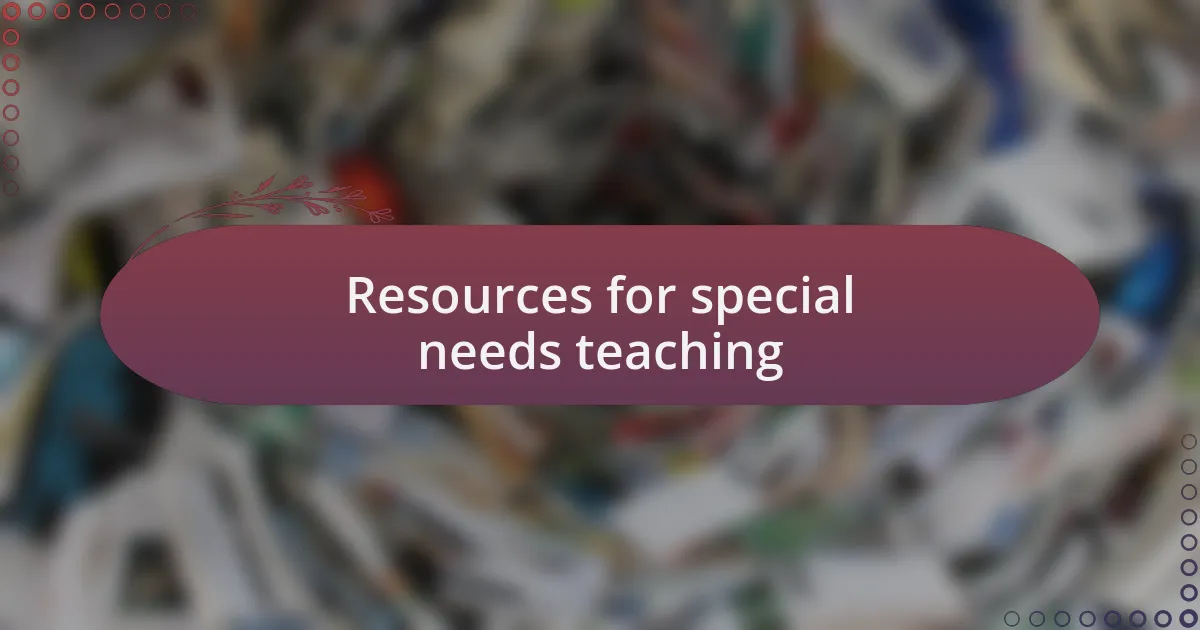
Resources for special needs teaching
When it comes to resources for teaching students with special needs, I often find that visual aids make a world of difference. For instance, I once incorporated colorful graphic organizers into a history lesson for a student with ADHD. Watching him create connections between events while visually mapping them out was incredible. Don’t you think visual tools can help bridge gaps in understanding?
I also swear by assistive technology. One of my students benefited immensely from text-to-speech software during our lessons. Initially, I was skeptical about its effectiveness, but seeing her comprehend complex texts independently changed my perspective entirely. Have you ever had a moment where technology opened new doors for learning?
Another invaluable resource is community support and training workshops. I remember attending a session focused on behavior management strategies, which equipped me with techniques to better support my students. Sharing experiences with other educators allowed me to refine my approaches and foster a more inclusive environment. Don’t you feel that collaboration can enhance our teaching practices?